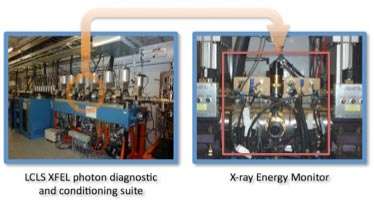Highest X-ray energy used to probe materials

Scientists for the first time have dived into the effect that an intense X-ray free electron laser (XFEL) has on materials.
Using the Linac Coherent Light Source (LCLS) facility at the SLAC National Accelerator Laboratory, Lawrence Livermore scientists probed nitrogen gas at X-ray energies of up to 8 keV (kiloelectronvolts), the highest X-ray energy ever used at an XFEL, to see how it behaved when the laser hit it.
The photoluminescence-based pulse-energy detector allowed the team to study the interaction - including electron dynamics and space charge effects - between nitrogen gas and the XFEL beam. Understanding the precise dynamics at work on these scales will forever change the understanding of chemistry, physics and materials science.
The XFEL's light is so bright at 8 kilo electron volts and so fast (it has a pulse length from 10 femtoseconds to 100 femtoseconds) that LLNL scientists were able to validate the physics of simulations done using nitrogen gas. (One femtosecond is one quadrillionth of a second).
"The detailed physics is very important for most LCLS experiments since it determines the interpretation of the results," said Lab scientist Stefan Hau-Riege. "The unique thing about this experiment is that it was performed upstream from the LCLS mirrors, and so we had access to the full range of LCLS X-ray energies (which went up to 8 keV at the time)."
The heart of the LCLS is a free-electron laser that produces beams of coherent, high-energy X-rays. Coherence - the phenomenon of all photons in a beam acting together in perfect lockstep - makes laser light far brighter than ordinary light. Since X-ray photons at the LCLS are coherent, the resulting beam of light will be as much as a billion times brighter than any other X-ray light source available today.
The LCLS also contains a femto-camera that can sequence together images of the ultra small, taken with the ultrafast pulses of the LCLS. Scientists are for the first time creating molecular movies, revealing the frenetic action of the atomic world.
The LCLS, and its cousins planned in Germany and Japan, improves on third-generation light sources. The third-generation sources are circular, stadium-size synchrotrons, and they produce streams of incoherent X-ray photons. Since their pulses are long compared to the motion of electrons around an atom, synchrotron light sources cannot begin to explore the dynamic motion of molecules.
The pulses of light from the fourth-generation LCLS are so short, lasting for just quadrillionths of a second, that its beam provides an X-ray strobe light to capture such atomic and molecular behavior.
More information: The research will appear in the July 27 online edition of Physical Review Letters.
Provided by Lawrence Livermore National Laboratory





















